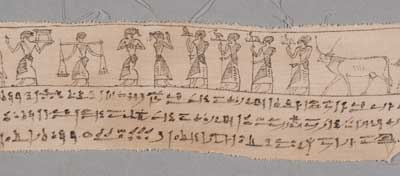This fragment of a shroud, or mummy wrapping, is made of finely woven pale brown linen, and dates to the early Ptolemaic period around 300 BC.
Depicted on the linen are scenes from the Book of the Dead, showing a funeral procession.

Linen, c. 300 BC
Acc #: 121.73, James Logie Memorial Collection
Purchased from Charles Ede Ltd., London

This fragment of a shroud, or mummy wrapping, is made of finely woven pale brown linen, and dates to the early Ptolemaic period around 300 BC.
Depicted on the linen are scenes from the Book of the Dead, showing a funeral procession.
The Book of the Dead contained spells for guiding the deceased through the underworld, and was first used in the New Kingdom, around 1550 BC. On this particular mummy wrapping it is possible to see a funeral procession moving from right to left. At the far left are men gathering offerings for the deceased, or for a funeral feast. We see a man butchering an ox, a man carrying the leg of the ox, a man gathering food offerings, another man carrying a leg of the ox, three men carrying furniture, and a set of scales. The man facing right is greeting four standard bearers with nomes, (signs which represent a district), including a hawk, an ibis and two jackals. Next comes an ox with a herdsman, a man with ritual objects, a funerary boat (with canopic jars), and a man pulling a sledge with an image of Anubis.

The language used here is Egyptian Hieratic, which was a cursive script used by priests that is read from right to left. Usually ink was applied with a brush to papyrus or linen (as here). This kind of text was quicker to work with than hieroglyphics but is related to them. Hieratic script is older, but developed alongside hieroglyphs.
By clicking "Accept All Cookies", you agree to the storing of cookies on your device to enhance site navigation, analyse site usage, and assist in our marketing efforts.
0800 827 748 (within NZ)
+64 3 369 3999
Ext: 92111 (from a campus landline)
Direct dial: 0800 823 637
University of Canterbury | A Fair Trade University